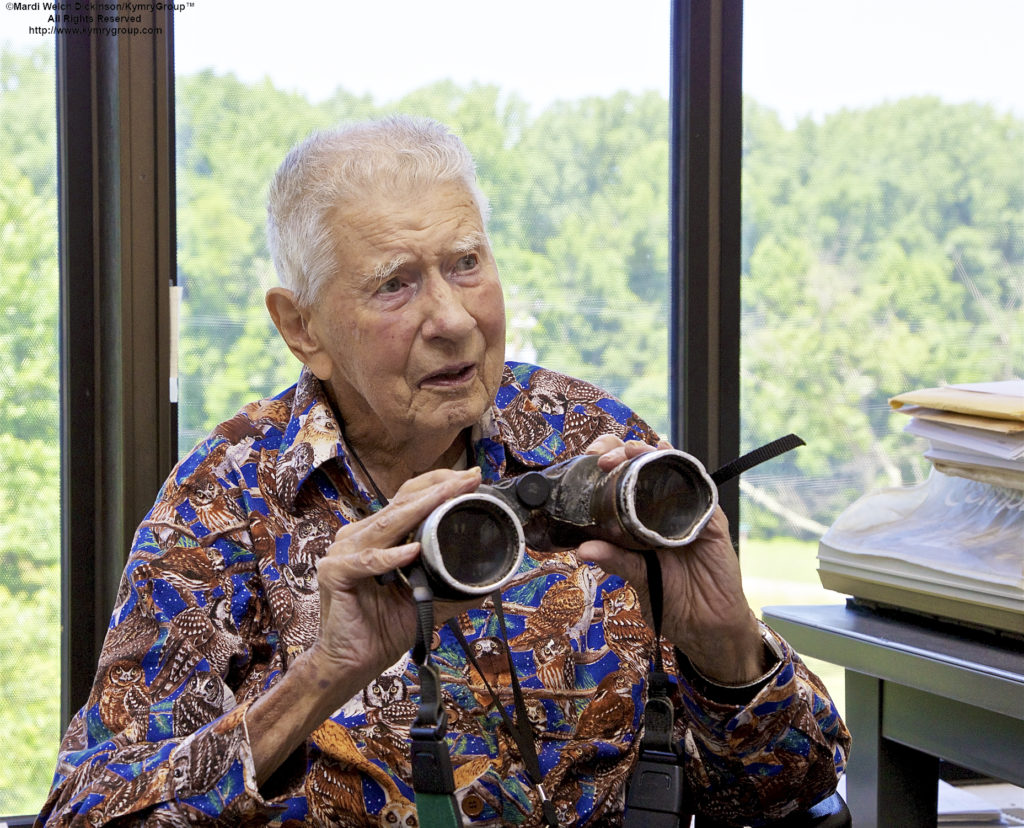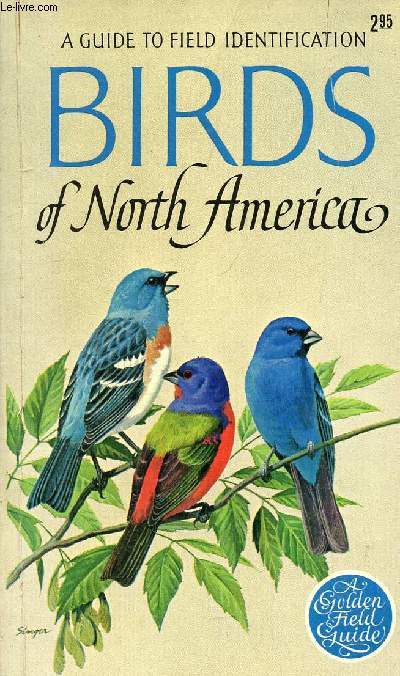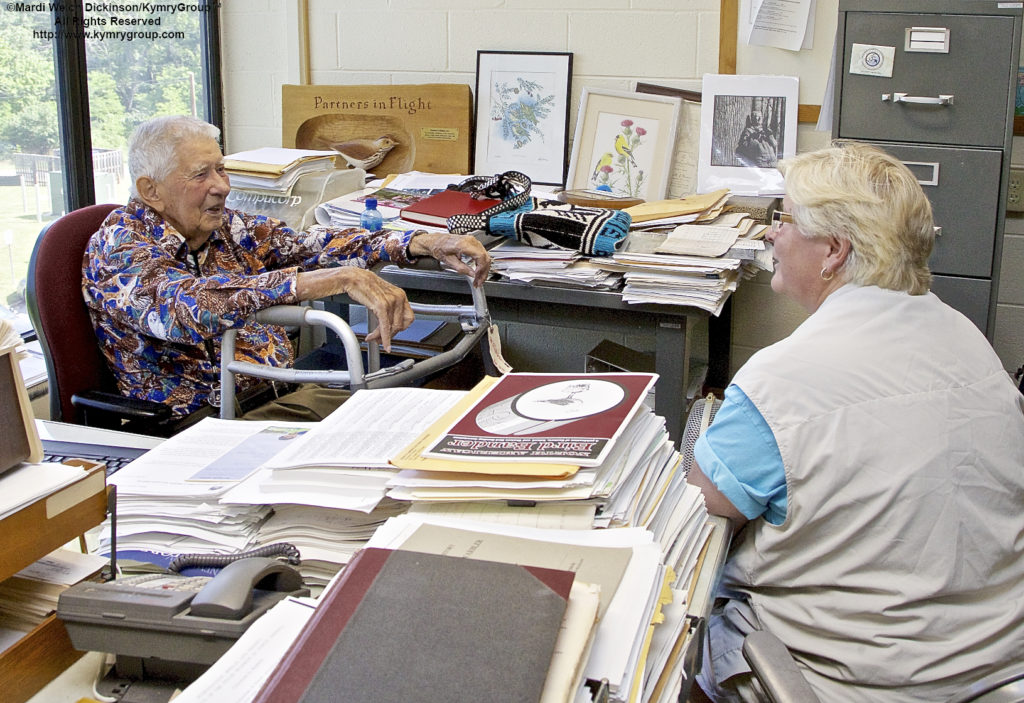BCR 083: Chandler S. Robbins; 1st For The Record, Legacy Interview™ Series

Chandler S. (Chan) Robbins, Emeritus “War Room” office at U.S. Department of the Interior, U.S. Geological Survey, Patuxent Wildlife Research Center, Laurel MD. Photo taken 6/30/16 ©Mardi W.Dickinson Kymry Group™ All Rights Reserved.

Chandler S. (Chan) Robbins at U.S. Department of the Interior, U.S. Geological Survey, Patuxent Wildlife Research Center, Laurel MD.
Show Notes:
- This was the last documented interview Chandler S. Robbins (Chan) ever did.
- Chandler Robbins recently celebrated his 98th birthday
- Patuxent Wildlife Research Center “Emiritus War Room”
- Chandler was banding birds in 1937 under a permit issued to his father.
- Robbins study & published the effects of the pesticide DDT in 1950’s sprayed on breeding bird populations in forests.
- North American Breeding Bird Survey
- Co-Authored A Guide to Field Identification, Golden Press in 1966.
- Negotiated the first treaty USA/Soviet Union Migratory Bird Treaty 1976.
- Laysan Albatross “Wisdom” Robbins banded in 1956, Rebanded in 2002.
- Wrote The Early Years chapter in The History of Patuxent.
- Currently writing and completing a History of Breeding Bird Atlas in the New World for a publication by The Nuttall Ornithological Club, among other projects.
Host Intro:
Chandler Robbins recently celebrated his 98th birthday with family in New Hampshire. Some weeks prior to that I visited Chan in his office aka the “Emiritus War Room” at the Patuxent Wildlife Research Center in South Laurel to conduct this interview. The visit was graciously facilitated by his daughter Jane, who pointed out that Chan still came to the office several times a week to work on ongoing projects. It is difficult to summarize the highlights of his 60 year career, but without doubt there are accomplishments that have had a profound impact on world wide conservation and modern ornithology. The Balimore Sun, May 26, 2016, quoted John Fitzpatrick, director of the Cornell Lab of Ornithology in Ithaca, New York, who described Robbins as “one of the world’s most important figures in ornithology and conservation.” What is sometimes missed in the press is the fact that he was an incredibly hard working and talented field scientist who worked collaboratively with a host of talented men and women.
Chandler was banding birds in 1937 under a permit issued to his father since he was under age at the time. After WWII he took a job as junior biologist in the national banding office at the Patuxent Research Center. He retired in 2005 from Patuxent. Some career highlights include:
DDT studies. He said it all started when the Department got a letter from a lady in the Midwest who was disturbed by the large die-off of robins on collage lawns from application of DDT. This led Robbins to study the effects of the pesticide DDT on breeding bird populations in forests that had been sprayed with DDT in the 1950’s and published the results in the Journal of Wildlife Management. These studies were ignored until Rachel Carson, who had been technical editor for the Journal, published Silent Spring several years later.
Forest Fragmentation. One of Robbin’s longest projects was a study of the effects of forest fragmentation on breeding birds. It began in Maryland with Eastern woodland birds and surrounding states in 1974, then spread to the wintering grounds of these birds in Mexico, the West Indies, Central America, and Venezuela. In the Latin American countries, he always collaborated with local biologists or organizations. They discovered that most songbirds required unfragmented forest on their breeding grounds, but in the winter they lived in fragmented forests that the resident tropical species avoided during their breeding season, so they would not be competing for food with the tropical birds. In the course of our prolonged field work in Guatemala and Mexico we provided enough documentation to assist in establishing the Cerro San Gil Reserve in Guatemala (47,600 ha.) and the Rancho Sandoval Reserve in Campeche, Mexico (8,000 ha.). At the Guatemala sites at Cerro San Gil, the conservation organization FUNDAECO established a research station which they named After Chandler Robbins.
He organized the North American Breeding Bird Survey and the data gathered from these BBS studies has had and is still having a profound effect throughout current ornithology.
He coauthored, with Herbert Zim, Bertel Bruun, and illustrated by Arthur Singer, the groundbreaking Birds of North America: A Guide to Field Identification, Golden Press in 1966 with revolutionary colored illustrations, and facing maps and descriptions.
In 1976, he was one of three Americans selected to write and negotiate the USA/Soviet Union Migratory Bird Treaty, which was the first treaty to protect not only the shared species, but also the habitats these species required, setting the example for future treaties.
With John Aldrich and Bob Stewart, Robbins served as technical editor of Audubon Field Notes/American Birds from 1951 through 1989
One of his most remarkable stories stems from chance encounters with an Albatross named “Wisdom”. He was involved in aircraft safety problems at the large airports, one of greatest problems was with nesting albatrosses near the runways at Midway atoll in the Pacific. One of the Laysan Albatrosses he banded there in 1956 was an adult female later to be known as Wisdom. Robbins re-banded Wisdom in 2002 and later learned she was the same bird that he had banded in 1956. In February 2016, Wisdom’s egg hatched under the care of her mate, and so it was that Wisdom was a mother again at the estimated age of 65.
He quietly helped revolutionize bird banding. Using the new Japanese mist nets he urged banders to carefully determine and record the age, sex and weight of each bird prior to release. Until then, banders simply ringed the birds and released them, missing opportunities to gather valuable data.
The Balimore Sun recounted this recent quote by Robbins, “It’s too quiet; there are not enough warblers anymore,” he lamented. “People don’t give birds a second thought when they use pesticides.” Chandler Robbins did and is still doing his share on this, it is now up to others to continue the work. Lets hear from our First “For The Record: Legacy Interview” with Chandler S. Robbins directly.

Chandler S. Robbins coauthored, with Herbert Zim, Bertel Bruun, and illustrated by Arthur Singer, the groundbreaking Birds of North America: A Guide to Field Identification, Golden Press in 1966 with revolutionary colored illustrations, and facing maps and descriptions.
BirdCallsRadio additional information:
Support BirdCallsRadio DONATE NOW OR ADVERTISING
BirdCallsRadio ON THE GO! Subscribe directly to Apple Podcasts; Stitcher; Spotify; iHeartRadio Google Play; to our podcast for Mac, PC & Android users emailed to you automatically so you won’t miss any BCR podcasts; and please leave us a rating and review if you would be so kind! We appreciate it!
Subscribe to our FREE E-News and be part of something greater. Stay up to date on all our episodes and exclusive offers by clicking on BirdCallsRadio and scrolling to the bottom and sign up with your email. All emails are confidential.


I met Chan in 1966 and was 18 years old and started working for the Patuxent Wildlife Research Center. He’s a great person and full of knowledge and wisdom. We all think the world of him at the Research Center. Chan is one of a kind for sure.
Dear Mardi,
My name is Erika Mittermaier. I am an amateur “bird watcher” at 31 years of age, working for the BLM (Bureau of Land Management) in Roseburg, Oregon on the wildlife/spotted owl crew here. This town was the epicenter for all of the logging legislation that came about in the 80’s with concern for over-harvesting affecting owl survival rates. Unfortunately, I see the increasingly discontiguous forest every day and hear the results in the negative space once taken up by many species of birds. We have had our funding cut, so we only run one MAPS station now…not enough…and our Murrelettes are still under-studied. No one seems to give a hoot about bird and forest health and it is depressing, but I retain some hope knowing young folks maybe getting into birding thanks to some charter schools teaching bird biology in grade school.
As I input our season’s owl data into the database, I am listening to all of your fantastic interviews Mardi, with these incredibly inspirational professionals. I have gathered an immense amount of appreciation for all of their efforts and am inspired to increase my own efforts with educational outreach to the public.
I just want to thank you from the bottom of my heart for all of your thoroughly enlightening interviews, but would like to express my sincere gratitude for this particularly life-changing episode. I was overwhelmed by the realism, and the aptitude/astuteness within Chan’s being, still at that age..along with his raw loyalty to birds. His endeavors are unmatched really, and I wanted to tell him that he is the most humble, deserved being I have heard speak – so I looked at the date of your interview, I saw that it was recent and could possibly write him to tell him these things before he passed. Unfortunately that has happened.
Tearing up as I write this, and attempting to get my emotion into an effective form of activism already, I have to ask a favor: Go to his grave give it a hug for me, and maybe have a birding event there in the morning, and if you can, band some birds this next year! Soon, I will apply for Chan’s award so I can do a Ph.D., incorporating science, education and conservation.
Thank you much,
Erika Mittermaier